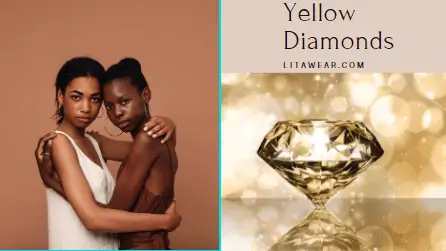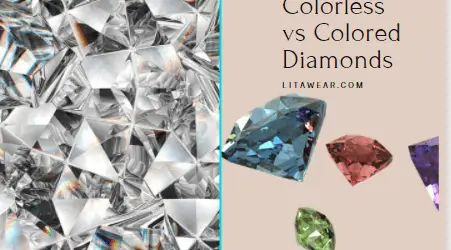One of the most exciting purchases you’ll ever make is buying a real diamond ring causing jaw-dropping reactions from your fiancé, significant other, or anyone who encounters a real piece of a bright-colored diamond piece of jewelry.
However, to avoid overpaying you need to know the secretive lingo, grading qualities, and of course, compare the different diamond colors responsible for the final evaluation of every earring, pendant, or band gemstone.
Diamond color refers to either white colorless diamonds (Type 1) or fancy colored diamonds (Type 2). Within Type 1 there are 5 descending levels (D-Z) known as the normal range where a colorless diamond is considered high-quality and yellow-brown hue is less valued. Fancy diamond grading differs.
Time to get into the brief, but the nitty-gritty of diamond stone color and their effect on gemstone quality, value, and buying as well as the underlying consumer benefits for you ultimately.
Diamond Colors Explained
The main reason diamonds even develop different colors lies in their simultaneous pressure and heat natural creation process under the earth. The result is diamonds of different colors like black diamond gemstones or lack of it (colorless). A natural diamond is either white or colored, whereas most diamonds are normal ranged gems.
Diamond Color Types Chart
| Diamond Color | Causation |
| Type 1 (Colorless/White-Yellow) | Atomic impurity |
| Type 2 (Fancy Colored) | No atomic impurity, Structural Anomaly |
| Source:Litawear.com, Wikipedia |
The atomic impurity or purity thereof is one of the main causes for the different diamond crystal colors as they appear to the eye during the light absorption process which largely determines our perception of the stone color.
Understanding Type 1 Diamonds
Type 1 diamonds tend to belong to what is known as the normal color range as defined by the gemstone industry standard of the Gemological Institute of America, GIA, though other reputable grading laboratories do exist worldwide.
More about the normal color range in a sec.
Understanding Type 2 Diamonds
The type 2 diamonds are regular diamonds too, only with a different crystal characteristic due to pressure, hydrogen, exposure, heating, or fractures. This will in turn result in a natural green diamond as well as a black, green, blue, or pink gem.
All these are extremely rare gems in the 1% range or less.
For example, in the case of pink diamonds which will unfortunately soon be seized to be mined since the worldwide leader, the pink diamond mine company Argyle of Australia, announced a mine shut down due to exhaustion.
Next to these two diamond-type classifications exist the more prominent diamond color grading scale worth paying attention to.
Diamond Color Chart
The diamond color chart is by far the most important and respected grading scale in comparing and determining the value of a diamond color within the 4 C´s system (carat, clarity, cut, color) as labeled by GIA.
| Colorless | Near Colorless | Faint Yellow | Very Light Yellow | Light Yellow |
| D, E, F | G, H, I, J | K, L, M | N, O, P, Q, R | S, T, U, V, X, Y, Z |
| Highest Colorless Quality – High Quality – Midrange | Lower – Lowest Color Quality | |||
| Source:Litawear.com (Table), GIA |
Diamond Colorless Explained
The colorless diamond group is the most valuable within the color grading system in terms of gemstone quality and asking price when looking at coloration only.
- D – No or near no color visible to the eye, the highest diamond color quality, rare, most valued
- E – Identical with D, only difference in color visible by trained grader with complete stone sets
- F – Identical with D & E, minute variations observed only by trained grader, light conditions
Near Colorless Explained
The second most valued group is the near colorless stones in descending order from G – J.
- G – Closest to the colorless group, only observable nuances by graded expert with magnifier
- H – Identical to G, only visible to the eye by a 10-20xmagnifier used by a pro grader
- I – Identical to G & H, only variation detectable by diamond grader with magnifying glass
- J – Identical to G, H, I, J and coloration can be traced only by expert with magnifier
Faint Yellow Explained

Still, great quality diamond faint yellow color possess minute color “impurities” hard to detect
- K – Minute yellowish color can be easily detected by magnifier from expert, not consumer
- L – Identical to K, only slightly more faint yellow, though only gem grader can find out
- M – Identical to K & L, just bit more fainted to a yellowish color identifiable by pro grading
Very Light Yellow Explained
These are compared to the colorless, near colorless, and faint yellow of visibly lower color quality ranging yellow to brown-like taint.
- N – Yellow coloring visible to a professional diamond grader, less qualitative
- O – Identical to N, with more yellowish taint in it
- P – Identical to N & O, though even more yellow to darker brownish tone
- Q – Identical to N, O, & P including much more brown coloring
- R – Identical to N, O, P, & Q more yellow, more brown hue
Light Yellow Explained
This diamond color range is the lowest for quality grading and, for that matter, is least used in fine jewelry.
- S – T – U – V – W – X – W – The least desirable color range by jewelers and designers most of the time as result of the low-quality colors yellow and brown respectively
How Are Diamonds Graded By Color?
The process of diamond grading by color includes:
- diamond master stones (usually 5 color ranges) at a respected or officially certified laboratory like the Gemological Institute of America (GIA),
- a knowledgeable diamond grade expert and finally
- consistent light conditions at the lab against which an unset diamond is tested.
Fancy Colored Diamonds Chart
A fancy colored diamond gem can have the same or even more value than a normal range D – Z precious gemstone, depending on the rareness of its color, when everything else (carat, clarity, and cut) is the same.
In fact, the color of a natural colored diamond is the most important factor in terms of its valuation. Unlike normal range colorless diamonds that heavily rely on the 4 C´s grading scale to determine a gemstone’s value.
However, which classification is naturally colored diamonds referenced by, if not by diamond normal range of colorless diamond gems?
Fancy Colored Grading Chart
Chart Source:GIA
Understanding Fancy Colored Diamond Grading
This is a continuous hue circle image showing us the entire color range of the 27 colored diamonds as identified by the Gemological Institute of America.
This fancy colored diamond circle is further broken down into 3 distinctive color circles to satisfy the scaled grading of the various ranges in terms of hue, tone, and, saturation.
These are responsible for the color the eye sees when looking at fancy diamonds of color.
The three attributes looked at when comparing and evaluating real colored diamonds are:
- Hue – The appearance of red, green, blue, and colors in between
- Tone – Comparative lightness and darkness of color
- Saturation – Comparative strength or weakness of color
Depending on these 3 essential colored diamond attributes a fancy-colored diamond is being compared and graded within the 27 hue circle, for example:
- Lighter tone hue circle tends to have weak saturation, grayish
- Darker tone hue circles too tend to have weak saturation
- Strong saturations like blue diamonds on the other are located low left-side
Here’s a visual chart demonstration of the varying hue’s and their associated gemstone attributes:
Hue, Tone, And Saturation in Colored Diamonds
| Fancy Diamond Circle | Attribute |
| First Circle (Continuous) | Strong Saturation (all 27 colored diamonds) |
| Second Circle (Lighter Tone) | Fancy Light, Weak Saturation (grayish)* |
| Third Circle (Darker Tone) | Fancy Dark, Weak Saturation (gray-brown) |
| Source:Litawear.com, *resemble D-Z color scale pale yellow |
The diamond color sensations (what we see or perceive to see) are therefore saturate at different spaces (relative strength of weakness of coloration) which ultimately translates into the hue value.
A breakdown of the circles into 8 subgroups has further been developed to deep guide the diamond grader and retailer into the fascinating world of accurately measuring the color purity and intensity of natural colored diamonds.
8 Colored Diamond Hue Circles
- Faint
- Very Light
- Light
- Fancy Light (comparable with GIA’s D-Z normal color range)
- Fancy
- Fancy Intense
- Fancy Vivid, Fancy Deep or Fancy Dark
Pros and Cons of Fancy Diamond Grading and Chart
The grading of a fancy colored diamond is not an easy fit and historically laboratories have tried hard, only a few gem laboratories like GIA have in our millennium recently achieved success and worldwide recognition.
The reason is that there is no 100% grading system of natural colored diamonds, because of the unique attributes of every diamond in terms of hue, tone, and color characteristics.
This is a downside the 27 hue circle chart tries to resolve with a great satisfactory rate within the diamantaires and consumers alike.
Colors in Colorless Diamonds
In fact, some precious stones like the famous deep blue-gray color Hope diamond (Type II, VS1) of 45.52 carats in the Smithsonian Museum estimated at $250 million, is a truly unique boron impure gem that shows fluorescence in red under brief ultraviolet light exposure.
Though technically colorless/ very slightly included/, the Hope diamond is capable to visualize under certain light conditions a color spectrum that is rare while being chemically pure.
These benefits and downsides are part of diamond color grading, despite having high-tech magnifiers and labs having tested hundreds of thousands of real fancy colored diamond stones along the way.
Which Diamonds Are Worth Most? — Colorless or Colored

Both have 2 different grading evaluation processes that result in varying monetary values depending on the specific grading outcome. Real colorless diamonds are graded by carat weight, clarity, color, cut (4C´s) while fancy colored diamonds are under the so-called Continuous Hue Circle grading system.
Diamond Color and Precious Metal Setting
Whether you decide to buy a vividly colored diamond or classic flawless brilliant white ring you hardly do this by getting a loose stone.
You probably purchase a precious diamond gemstone with a metal setting and depending on the combination of diamond (colored or colorless) and metal (e.g., gold or silver) your diamond color may appear differently, and cost differently.
What Is The Best Diamond Color For Precious Metals?
| Precious Metal | Best Diamond Color |
| Yellow Gold | (Colorless) D, E, F (Near Colorless) G, H, I, J(Faint Diamonds) K, L, M |
| Rose Gold | (Colorless) D, E, F (Near Colorless) G, H, I, J(Faint Diamonds) K, L, M |
| White Gold | (Colorless) D, E, F (Near Colorless) G, H, I, J |
| Platinum | (Near Colorless) G, H, I, J |
| Source:Litawear.com, Gemsociety.org (partly) |
Please bear in mind that these are rough diamond buying tips hopefully giving you tangible, rip-off safe information for making an informed decision, completely free of charge.
Color of diamond, metal setting, and cut
Nevertheless, diamond shapes and cuts from oval, heart, cushion, marquise, or radiant cut settings, also determine how your beautiful jewelry piece will look like. Hidden under a huge yellow gold – round cut or visible as a stunning fiancé emerald cut sparkling diamond.
This is your complete comparison and buying guide of diamond color gemstones and if you still have a question or two, find more in-depth posts on the site or kindly drop me your message.

